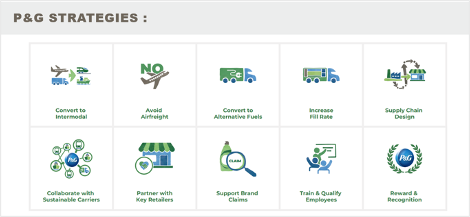As one of the world’s largest consumer products company, P&G China ships a significant amount of products to meet the daily needs of over 1 billion consumers. As part of our corporate Ambition 2030 sustainability program to accelerate progress on climate change, P&G committed to improve our upstream finished product freight emissions efficiency 50% by 2030 versus 2020 baseline. Furthermore, P&G adopted the global industry advanced greenhouse gas calculation methodology, called GLEC (Global Logistics Emissions Council), accounting for the emissions across all life cycle activities (Well-To-Wheel) for any type of transport mode.
To deliver this ambitious goal, P&G defined 10 strategies, including conversion to more efficient modalities (from Airplane or Truck to Train or Boat), conversion to more sustainable fuels, vehicle fille rate increase, supply network optimization, partnership and collaboration with carriers, retailers and the broader transportation industry, use of new technology, internal employees training and recognition, etc.

See below 2 examples in China to showcase these strategies:
Note that by converting shipments from diesel truck to the less pollutive train or boat alternatives, we eliminate approximately 75% of the emissions. In company fiscal year 2122*, we are partnering with our transportation suppliers to double our intermodal transportation share (versus company fiscal year 2021+), reducing the equivalent of approximately 2,400 trucks (shipping from Guangzhou to Wuhan (1000km)).
In the past company fiscal year+, we started up new smart manufacturing centers in Guangzhou from which we launched new direct-supply-to-consumer solution. Through seamless collaboration with our retail partners, we connected our supply chain nodes physically and digitally in an optimal way. Doing so, we delivered million parcels from our smart manufacturing centers directly to consumers with high agility and speed, thanks to the short and lean supply chain. The elimination of the unnecessary nodes and touches in the supply chain has improved the transport performance with approximately 190,000 tonne-km, reducing our transport emissions footprint.
*July 2021 - June 2022
+July 2020 - June 2021
If any divergences arise between the English and the Chinese versions of this report, please refer to the Chinese version.
(The above content is provided by the brand, and the authenticity of the data is the responsibility of the brand)